Melting Parameterizations
Methods
A number of melting parameterisations are implemented, which can be set with:
GeoParams.MeltingParam.MeltingParam_Caricchi Type
MeltingParam_Caricchi()Implements the T-dependent melting parameterisation used by Caricchi, Simpson et al. (as for example described in Simpson)
Note that T is in Kelvin. As default parameters we employ:
Which gives a reasonable fit to experimental data of granodioritic composition (Piwinskii and Wyllie, 1968):

References
- Simpson G. (2017) Practical finite element modelling in Earth Sciences Using MATLAB.
GeoParams.MeltingParam.MeltingParam_Smooth3rdOrder Type
MeltingParam_Smooth3rdOrder()Implements the a smooth 3rd order T-dependent melting parameterisation (as used by Melnik and coworkers)
Note that T is in Kelvin.
As default parameters we employ:
which gives a reasonable fit to experimental data for basalt.
Data for rhyolite are:
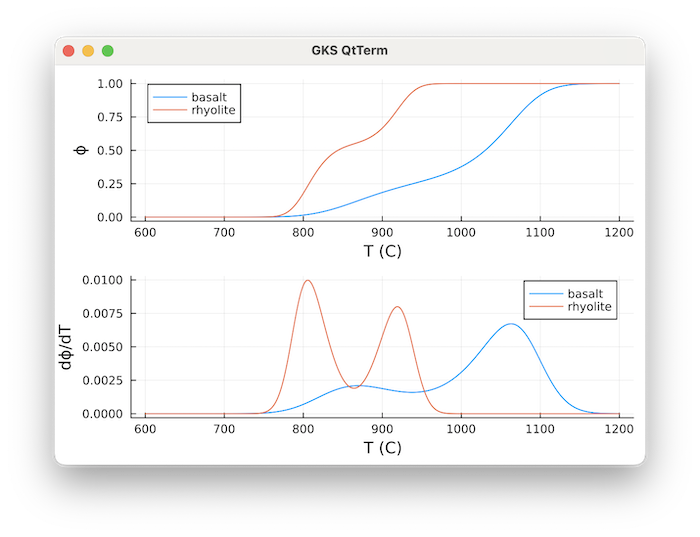 Red: Rhyolite, Blue: Basalt
Red: Rhyolite, Blue: Basalt
References
sourceGeoParams.MeltingParam.MeltingParam_5thOrder Type
MeltingParam_5thOrder(a,b,c,d,e,f,T_s,T_l)Uses a 5th order polynomial to describe the melt fraction phi between solidus temperature T_s and liquidus temperature T_l
Temperature T is in Kelvin.
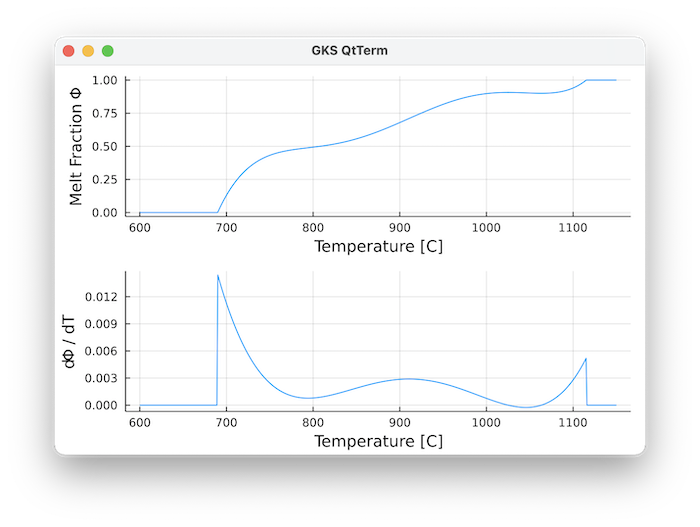
The default values are for a composite liquid-line-of-descent:
the upper part is for Andesite from: (Blatter, D. L. & Carmichael, I. S. (2001) Hydrous phase equilibria of a Mexican highsilica andesite: a candidate for a mantle origin? Geochim. Cosmochim. Acta 65, 4043–4065
the lower part is extrapolated to the granitic minimum using the Marxer & Ulmer LLD for Andesite (Marxer, F. & Ulmer, P. (2019) Crystallisation and zircon saturation of calc-alkaline tonalite from the Adamello Batholith at upper crustal conditions: an experimental study. Contributions Mineral. Petrol. 174, 84)
GeoParams.MeltingParam.MeltingParam_4thOrder Type
MeltingParam_4thOrder(b,c,d,e,f,T_s,T_l)Uses a 4th order polynomial to describe the melt fraction phi between solidus temperature T_s and liquidus temperature T_l
Temperature T is in Kelvin.
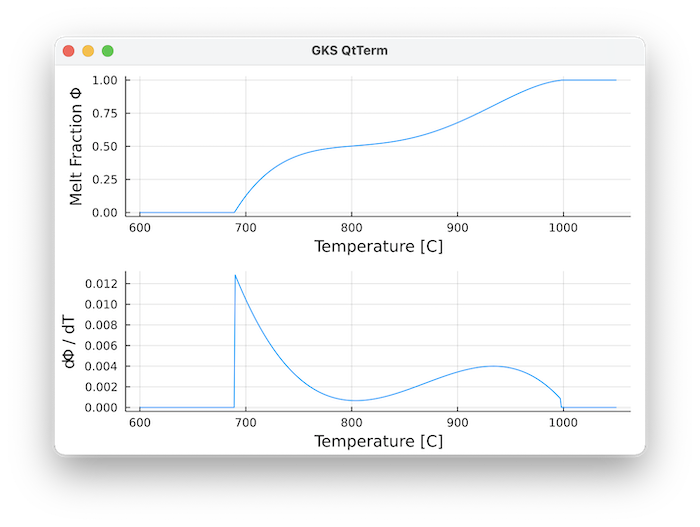
The default values are for Tonalite experiments from Marxer and Ulmer (2019):
- Marxer, F. & Ulmer, P. (2019) Crystallisation and zircon saturation of calc-alkaline tonalite from the Adamello Batholith at upper crustal conditions: an experimental study. Contributions Mineral. Petrol. 174, 84
GeoParams.MeltingParam.MeltingParam_Quadratic Type
MeltingParam_Quadratic(T_s,T_l)Quadratic melt fraction parameterisation where melt fraction
Temperature T is in Kelvin.
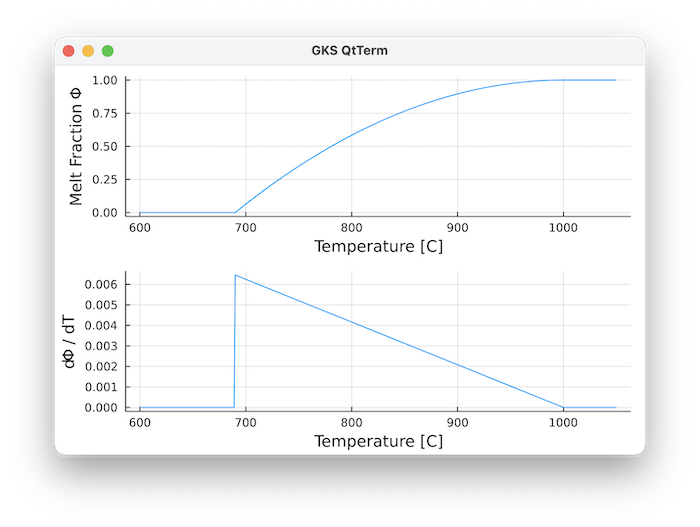
This was used, among others, in Tierney et al. (2016) Geology
sourceGeoParams.MeltingParam.MeltingParam_Assimilation Type
MeltingParam_Assimilation(T_s,T_l,a)Melt fraction parameterisation that takes the assimilation of crustal host rocks into account, as used by Tierney et al. (2016) based upon a parameterisation of Spera and Bohrson (2001)
Here, the fraction of molten and assimilated host rocks
Temperature T is in Kelvin.
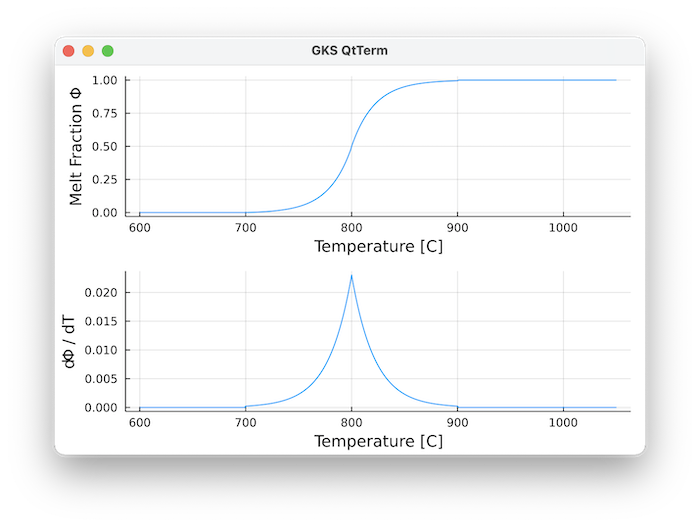
This was used, among others, in Tierney et al. (2016), who employed as default parameters:
References
Spera, F.J., and Bohrson, W.A., 2001, Energy-Constrained Open-System Magmatic Processes I: General Model and Energy-Constrained Assimilation and Fractional Crystallization (EC- AFC) Formulation: Journal of Petrology, v. 42, p. 999–1018.
Tierney, C.R., Schmitt, A.K., Lovera, O.M., de Silva, S.L., 2016. Voluminous plutonism during volcanic quiescence revealed by thermochemical modeling of zircon. Geology 44, 683–686. https://doi.org/10.1130/G37968.1
GeoParams.MeltingParam.SmoothMelting Type
SmoothMelting(; p=MeltingParam_4thOrder(), k_sol=0.2/K, k_liq=0.2/K)This smoothens the melting parameterisation
and liquidus:
The resulting melt fraction
The width of the smoothening zones is controlled by
This is important, as jumps in the derivative
Example
Let's consider a 4th order parameterisation:
julia> using GLMakie, GeoParams
julia> p = MeltingParam_4thOrder();
julia> T= collect(650.0:1:1050.) .+ 273.15;
julia> T,phi,dϕdT = PlotMeltFraction(p,T=T);The same but with smoothening:
julia> p_s = SmoothMelting(p=MeltingParam_4thOrder(), k_liq=0.21/K);
4th order polynomial melting curve: phi = -7.594512597174117e-10T^4 + 3.469192091489447e-6T^3 + -0.00592352980926T^2 + 4.482855645604745T + -1268.730161921053 963.15 K ≤ T ≤ 1270.15 K with smooth Heaviside function smoothening using k_sol=0.1 K⁻¹·⁰, k_liq=0.11 K⁻¹·⁰
julia> T_s,phi_s,dϕdT_s = PlotMeltFraction(p_s,T=T);We can create plots of this with:
julia> plt1 = plot(T.-273.15, phi, ylabel="Melt Fraction ϕ", color=:red, label="original", xlabel="Temperature [C]")
julia> plt1 = plot(plt1, T.-273.15, phi_s, color=:black, label="smoothened", legend=:bottomright)
julia> plt2 = plot(T.-273.15, dϕdT, ylabel="dϕ/dT", color=:red, label="original", xlabel="Temperature [C]")
julia> plt2 = plot(plt2, T.-273.15, dϕdT_s, color=:black, label="smoothened", legend=:topright)
julia> plot!(plt1,plt2, xlabel="Temperature [C]", layout=(2,1))The derivative no longer has a jump now:
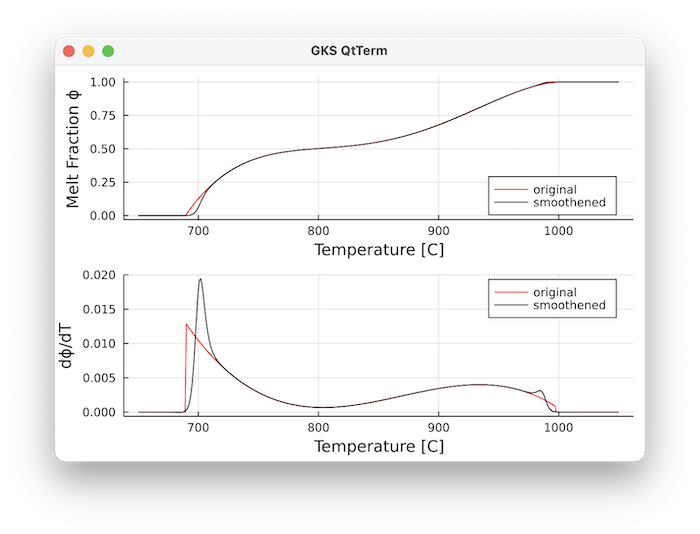
Computational routines
To compute the melt fraction at given T and P, use:
GeoParams.MeltingParam.compute_meltfraction! Function
compute_meltfraction!(ϕ::AbstractArray{<:AbstractFloat}, P::AbstractArray{<:AbstractFloat},T:AbstractArray{<:AbstractFloat}, p::PhaseDiagram_LookupTable)In-place computation of melt fraction in case we use a phase diagram lookup table. The table should have the column :meltFrac specified.
compute_meltfraction(ϕ::AbstractArray{<:AbstractFloat}, Phases::AbstractArray{<:Integer}, P::AbstractArray{<:AbstractFloat},T::AbstractArray{<:AbstractFloat}, MatParam::AbstractArray{<:AbstractMaterialParamsStruct})In-place computation of melt fraction ϕ for the whole domain and all phases, in case an array with phase properties MatParam is provided, along with P and T arrays.
GeoParams.MeltingParam.compute_meltfraction Function
compute_meltfraction(P,T, p::AbstractPhaseDiagramsStruct)Computes melt fraction in case we use a phase diagram lookup table. The table should have the column :meltFrac specified.
ϕ = compute_meltfraction(Phases::AbstractArray{<:Integer}, P::AbstractArray{<:AbstractFloat},T::AbstractArray{<:AbstractFloat}, MatParam::AbstractArray{<:AbstractMaterialParamsStruct})Computation of melt fraction ϕ for the whole domain and all phases, in case an array with phase properties MatParam is provided, along with P and T arrays.
You can also obtain the derivative of melt fraction versus temperature with (useful to compute latent heat effects):
GeoParams.MeltingParam.compute_dϕdT! Function
compute_dϕdT!(ϕ::AbstractArray{<:AbstractFloat}, Phases::AbstractArray{<:Integer}, P::AbstractArray{<:AbstractFloat},T::AbstractArray{<:AbstractFloat}, MatParam::AbstractArray{<:AbstractMaterialParamsStruct})Computes the derivative of melt fraction ϕ versus temperature T, \frac{\partial \phi}{\partial T} for the whole domain and all phases, in case an array with phase properties MatParam is provided, along with P and T arrays. This is employed, for example, in computing latent heat terms in an implicit manner.
GeoParams.MeltingParam.compute_dϕdT Function
compute_dϕdT(P,T, p::AbstractPhaseDiagramsStruct)Computes derivative of melt fraction vs T in case we use a phase diagram lookup table. The table should have the column :meltFrac specified. The derivative is computed by finite differencing.
ϕ = compute_dϕdT(Phases::AbstractArray{<:Integer}, P::AbstractArray{<:AbstractFloat},T::AbstractArray{<:AbstractFloat}, MatParam::AbstractArray{<:AbstractMaterialParamsStruct})Computates the derivative of melt fraction ϕ versus temperature T for the whole domain and all phases, in case an array with phase properties MatParam is provided, along with P and T arrays. This is employed in computing latent heat terms in an implicit manner, for example
Also note that phase diagrams can be imported using PerpleX_LaMEM_Diagram, which may also have melt content information. The computational routines work with that as well.
Plotting routines
You can use the routine PlotMeltFraction to create a plot, provided that the GLMakie package has been loaded
GeoParams.PlotMeltFraction Function
T,phi,plt = PlotMeltFraction(p::AbstractMeltingParam; T=nothing, plt=nothing, lbl=nothing)Creates a plot of temperature T vs. melt fraction, as specified in p. The 1D curve can be evaluated at a specific pressure P which can be given as a scalar or as an array of the same size as T
Optional parameters
T: temperature rangeP: pressureplt: a previously generated plotting objectlbl: label of the curve
Example
julia> p = MeltingParam_Caricchi()
julia> T,phi,dϕdT = PlotMeltFraction(p)you can now save the figure to disk with:
julia> using Plots
julia> savefig(plt,"MeltFraction.png")